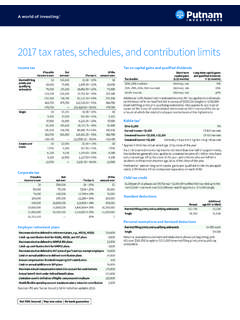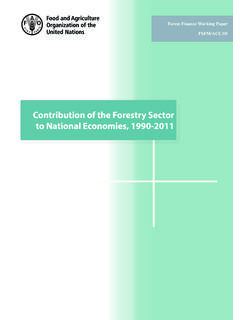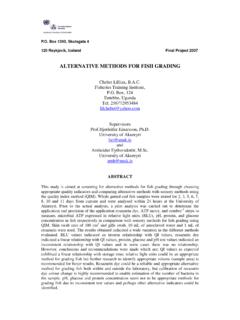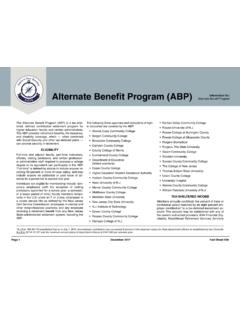Transcription of THE CONTRIBUTION OF ALTERNATIVE …
1 1 THE CONTRIBUTION OF ALTERNATIVE education BY ANNE SLIWKA1 This chapter introduces the concept of ALTERNATIVE education in its various different forms and approaches. The author explores the context, history and development of several ALTERNATIVE forms of education utilised worldwide. In addition she explores the notions of the culture of learning for each, including the conception of the learner, realisation of the learning environment, role of teachers, curricula and culture of assessment. The chapter also calls for a reassessment of ALTERNATIVE models of education in light of what the learning sciences reveal on cognitive and social processes which result in effective learning. ALTERNATIVE education : a fragmented landscape Lacking a precise meaning, the term ALTERNATIVE education describes different approaches to teaching and learning other than state-provided mainstream education , usually in the form of public or private schools with a special, often innovative curriculum and a flexible programme of study which is based to a large extent on the individual student s interests and needs (Raywid, 1988; Koetzsch, 1997; Aron, 2003; Carnie 2003).
2 Although in its broadest sense, the term ALTERNATIVE education covers all educational activities that fall outside the traditional school system (including special programmes for school dropouts and gifted students, home schooling, etc.) this paper focuses on models of schooling that have paved the way for alternatives to mainstream school systems provided by the State. Across the world, we find a broad range of ALTERNATIVE forms of education rooted in different philosophies. Thus, the landscape of ALTERNATIVE education is highly fragmented, which makes it difficult to quantify the number of students in ALTERNATIVE schools and programmes. Large, global networks of ALTERNATIVE schools based on particular educational concepts such as Montessori and Waldorf/Steiner pedagogy coexist with some new movements in ALTERNATIVE schooling as well as individual ALTERNATIVE schools.
3 In addition, several OECD school systems have created legislation that makes room for and funds ALTERNATIVE schools and education programmes within public school systems (Rofes and Stulberg, 2004). Historically, ALTERNATIVE models of education have coexisted with the public education system ever since its inception in the first half of the 19th century (Raywid, 1999). Attempts by the state to provide a common, culturally unifying education for all children have provoked the response of educators, parents and students who have declined to participate in these systems. Their reasons are manifold, and the forms of schooling (and non-schooling) they designed are equally diverse. The history of ALTERNATIVE education is a colourful story of social reformers and individualists, religious believers and romantics (Miller, 2007). In the United States, for example, Horace Mann s pioneering efforts to centralise public schooling were opposed from the start by religious leaders and other critics who perceived education to be a personal, family and community endeavour, not a 1 Anne Sliwka, , is Professor of education at the University of Trier in Germany.
4 Her research focuses on school development, teacher education and education for democratic citizenship. political programme to be mandated by the State. Many critics of the public school system referred to Jean-Jacques Rousseau s mile, published in 1762, in which he argued that education should follow the child s innate growth rather than the demands of society. Throughout the 19th century, education reformers in several countries accused their state school systems of disciplining young people for the sake of political and social uniformity and the success of an emerging industrial society. Bronson Alcott, for example, started the Temple School in Boston as early as 1834 because he rejected the rote memorisation and recitation predominant at early American schools. The first decades of the 20th century saw the advent of several ALTERNATIVE education movements that proved to be influential even today.
5 With her influential book The Century of the Child (1909), the Swedish educator Ellen Key was among the first of several advocates of child-centred education . The German education reformers Hermann Lietz, Paul Geheeb and Kurt Hahn founded reformist rural boarding schools ( Landerziehungsheime ) that were meant to provide children with a holistic education secluded from the negative effects of industrial urban life. In 1907, the Italian paediatrician Maria Montessori opened the first Casa de Bambini, a house of elementary education based on her own observations in child development. The first Waldorf school was founded by Austrian philosopher Rudolf Steiner in 1919. Because of official criticism of his innovative teaching methods, French educator, C lestin Freinet in 1935 resigned from his job as public school teacher to start his own school in Vence. In North America, John Dewey, Francis Parker and others formed a powerful progressive education movement based on the belief that education should primarily serve the needs of children and focus on understanding, action and experience rather than rote knowledge and memorisation.
6 During the 1960s and 1970s, ALTERNATIVE education grew into a widespread social movement. Writers like Ivan Illich, Neill and Hartmut von Hentig in Europe, John Holt, Jonathan Kozol and Herbert Kohl in the United States and Paulo Freire in Brazil questioned the values and methods of public schooling. The period between 1967 and 1972 in particular saw profound criticism of public education , resulting in student demonstrations and teacher strikes in many countries. As a result, the first magnet schools were introduced in the US public school system. By the 1990s, the transformation of the industrial to a knowledge economy had stimulated a debate about the future of the standard model of schooling (Bransford, Brown and Cocking, 2000; Bereiter, 2002; Hargreaves, 2003). In recent years, several OECD school systems have made provisions for the greater autonomy of state schools and some countries have made it possible for parents and innovative educators to receive public funding for the foundation of schools with special profiles, such as Charter schools in the United States and Alberta, Canada, Foundation schools in England or Designated Character schools in New Zealand.
7 With the beginning of the 21st century, many teaching practices developed in ALTERNATIVE schools, such as student-centred and independent learning, project-based and cooperative learning, as well as authentic assessment seem to have gone mainstream by influencing the culture of public education . Global networks of ALTERNATIVE schools Montessori schools (Lillard, 1996; Kahn, Dubble and Pendleton, 1999; Seldin and Epstein, 2003) pursue an educational philosophy and methodology, characterised by a special set of didactic materials, multi-age classrooms, student-chosen work in longer time blocks, a collaborative environment with student mentors, absence of testing and grades, and individual and small group instruction in academic and social skills. The programme name is not copyrighted and many mainstream schools across the world have now adopted parts of the Montessori methodology. Most schools entirely built on the Montessori methodology and philosophy are, however, organised in international and national networks such as the International Montessori Council or the American Montessori Society.
8 Waldorf schools (Petrash, 2002; Clouder and Rawson, 2003; Masters, 2005) also known as Steiner schools, are based on the educational ideas of the philosopher Rudolf Steiner. Waldorf education is currently practiced in kindergartens and schools in 60 countries and is thus, together 3 with Montessori education , the predominant form of ALTERNATIVE education around the globe. Waldorf education aims at developing children and adolescents into free, moral and integrated individuals through integrating practical, artistic and intellectual approaches into the teaching of all subjects. Round Square Schools (Tacy, 2006), of which there are currently about 50 on all five continents, are based on concepts of experiential educational developed by Kurt Hahn, who believed that schools prepare students for life by experiencing it in authentic learning situations as generated by work projects, community services, leadership training, international exchanges and different forms of outdoor exploration and adventure.
9 All Round Square Schools emphasise learning through doing with the aim of developing every student academically, physically, culturally and spiritually, through a process of self-confrontation and self-formation within the supportive environment of a school community. Free or democratic schools (Lamb, 1995; Gribble, 1998) are organised around the principles of autonomy and democracy. The oldest democratic school, Summerhill, a boarding school in Southern England, was founded in 1921 by the Scottish teacher Neill. Sudbury Valley School, radically democratic school in Massachusetts/USA, has served as a model for many subsequent democratic schools. Today, about 100 schools around the world describe themselves as free or democratic schools. Since 1993, free schools have formed a loose network. While official rules about the organisational principles of democratic or free schools would contradict the schools independent spirit, they share many common characteristics: decisions about the school are taken by a self-governing school body, in which each student and each teacher has one vote in a majority voting system.
10 Escuelas Nuevas are ALTERNATIVE schools based on the idea of improved rural and urban basic education for children from low-income families. Started in 1987, there are now more than 20 000 Escuelas Nuevas in Colombia as well as in 14 other Latin American countries, the Philippines and Uganda schools that have proven to be effective according to the World Bank and UNESCO, among others. The schools pedagogy emphasises respect for the rights of children and is based on innovative educational projects involving a range of educational materials that encourage collaborative, participatory and personalised teaching methods. Schools are organised as community schools, involving the wider community as well as students families who are invited to play an active role in school activities and their child s learning. In addition to the ALTERNATIVE schools that are part of broader networks, there are numerous individual ALTERNATIVE schools across the world.
















